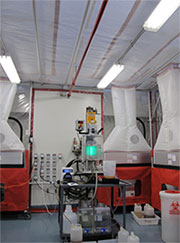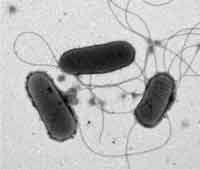“Novel” Food Processing Technologies Promote Nutrition and Food Safety
By Jaan Koel
Agriculture and Agri-Food Canada operates 19 research centers. One of them is located in Guelph, Ontario, about an hour’s drive west from Toronto.

Novel light system for treatment of drinks and beverages is being tested inside a “bio bubble” at GFRC’s pilot plant in Guelph, Ontario
The GFRC—Guelph Food Research Center—carries out world-class research in food safety and quality, reducing food safety threats as well as generating knowledge that helps the Canadian agri-food sector to develop health promotion tools that protect consumers and add nutritional value throughout the food chain.
One of things that GFRC is focusing is on “Novel” food processing technologies. Since the beginning of the 19th century, the food industry has been centered on heating, refrigeration, freezing, drying, smoking, and salting of foods to preserve and process food on a broad industrial scale. “Novel” food processing technologies go a step further.
GFRC is on the leading edge—worldwide—of developing new ways of treating food that can make it not only safer, but also more nutritious, and profitable for producers.
Their research includes:
1. Hydrostatic Pressure; Light; Microwave: “We’re pleased to be on the leading edge of a number of new technologies,” says Guelph Food Research Centre Research Scientist and Food Process Engineer Tatiana Koutchma. “We are exploring a new generation novel food processing methods that can potentially be used for preservation and improved safety of foods.” These technologies include thermal and non-thermal methods for a variety of applications, including high hydrostatic pressure, pulsed and continuous ultraviolet light, and microwave heating. Research at the facility also centers on various micro-organisms and their surrogates–understanding kinetics of microbial destruction, knowledge of product heating using new processing systems, and establishing increasingly safe processing systems. “Accumulation of new knowledge is essential for transfer of novel technologies from the development stage to the commercialization stage,” says Koutchma. “The data we obtain will assist food companies to introduce new processes at different points of the supply chain and submit detailed scientific information to regulatory agencies for approval.
2. Destruction of Mycotoxins: Guelph Food Research Center is also exploring the effects of novel processing methods on the destruction of mycotoxins, such as patulin, which is produced by a wide range of molds, and which is connected to fruit spoilage. This is a health concern regarding fruit juices for both consumers and manufacturers. Current research compares degrees of patulin degradation using various wavelengths of UV light and mapping their respective quality attributes.
3. New Methods: GFRC is evaluating chemical, toxicological and nutritional aspects of foods and food ingredients using novel processing methods for the first time. Together with information on product microbiology, this information will be used to determine the safety levels of novel vs traditional processes and the effects they have on foods before they are sold and consumed.
4. UV and High Pressure Treatment: “Another area of interest for us is the effects of novel technologies on quality and health benefits of treated products and their application to enhance functional and nutritional values,” says Koutchma. “One example includes generation of vitamin D in mushrooms and milk from exposure to pulsed or UV light. Another is the possibility of reduction of sodium chloride in raw meat products by application of high pressure treatment to enhance functional properties of proteins.”
All of these methods, and several others, bear promise to help the food industry advance in providing nutritious and safe products to a growing population world-wide. GFRC is a recognized world-class food research facility operated and owned by Agriculture and Agri-Food Canada.
To have more articles like this emailed to your inbox, become a GFSR Member today!

-
 FeaturedRisk management
The Cost of a Breach: What a Cyberattack Could Mean for Food Safety Recalls
FeaturedRisk management
The Cost of a Breach: What a Cyberattack Could Mean for Food Safety Recalls
-
 FeaturedRisk management
Securing the Food Chain: How ISO/IEC 27001 Strengthens Cybersecurity
FeaturedRisk management
Securing the Food Chain: How ISO/IEC 27001 Strengthens Cybersecurity
-
 FeaturedRisk management
Revolutionizing Food Safety Training: Breaking Out of the “Check-the-Box” Mentality
FeaturedRisk management
Revolutionizing Food Safety Training: Breaking Out of the “Check-the-Box” Mentality
-
 GFSI Standards
GFSI 2025: Building Trust, Tech-Forward Solutions, and Global Unity in Food Safety
GFSI Standards
GFSI 2025: Building Trust, Tech-Forward Solutions, and Global Unity in Food Safety
-
 FeaturedFood Safety
Integrated Pest Management: Strategies to Protect Your Brand’s Reputation
FeaturedFood Safety
Integrated Pest Management: Strategies to Protect Your Brand’s Reputation
-
 FeaturedFood Safety Culture & Training
No Open Door Policy: Challenges That Impact Pest Control in Food Processing Plants
FeaturedFood Safety Culture & Training
No Open Door Policy: Challenges That Impact Pest Control in Food Processing Plants



